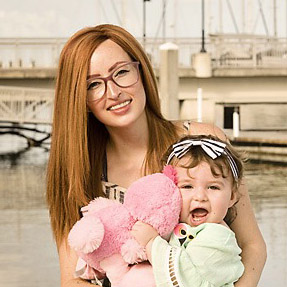For many years, women affected by ectodermal dysplasias at our Family Conferences and through our Women’s Survey have voiced their concerns about breastfeeding their children. In fact, of the 76.2% of survey participants who wanted to breastfeed, only 31.4% were successful. Almost half of the women needed to supplement breastfeeding with formula.
In this article, we share with you the findings of a research study which helps to explain why breast development in women affected by hypohidrotic ectodermal dysplasia (HED) can cause breastfeeding complications. Prof. Dr. Med. Holm Schneider, one of the investigators, summarizes their published study, Hypohidrotic Ectodermal Dysplasia: Breastfeeding Complications Due to Impaired Breast Development.
Research Study Findings
 By Prof. Dr. Med. Schneider
By Prof. Dr. Med. Schneider
Disorders of breast development are of great psychological relevance during puberty and adolescence and may later give rise to breastfeeding problems. In women with hypohidrotic ectodermal dysplasia (HED), impaired breast development is a common issue. Structured interviews with 38 female members of the German-Swiss-Austrian ectodermal dysplasias patient support group revealed a range of problems during the period of breastfeeding which were due to abnormal breast development.
Photographs of the mammary region confirmed an increased frequency of very flat, inverted or supernumerary nipples and lack of the small glands around the nipple (glands of Montgomery) in women with HED. Many affected mothers had not been able to breastfeed their first child. This difficulty was attributed mainly to the shape of their nipples and to the missing glands of Montgomery, which help protect the nipple, create an airlock between mouth and nipple while the infant is sucking and also help to guide the infant to find the nipple.
The knowledge that women with HED have more problems with breastfeeding than healthy mothers and that these are problems for which they cannot be held responsible needs to be taken into account during lactation counseling and should take the psychological pressure off affected women after giving birth.
The article is by Mandy Wahlbuhl-Becker, Florian Faschingbauer, Matthias W. Beckmann & Holm Schneider in the medical journal Geburtsh. Frauenheilk. 77, 377-382 (2017).
The Women’s Experience
We asked some women who are affected by HED to share their breastfeeding experience. These women didn’t necessarily participate in the study above.
Betty Kozanecki, affected by XLHED, had a reduced number of missing Glands of Montgomery. These are the sebaceous glands in the areola surrounding the nipple.
I was very keen to breastfeed our son when he was born in 1988. I had a perfect pregnancy followed by a difficult birth and high forceps delivery. My age was 38 years old. I had never had a diagnosis of ectodermal dysplasia. Of course, I knew I was missing teeth and had trouble in hot weather, but ectodermal dysplasia was never mentioned by any health professionals.
When trying to feed my son, he had trouble sucking due to his blocked nose and my small nipples made latching on difficult. We persevered using a nipple shield as I firmly believed breast milk was best for him and was encouraged by hospital staff. I tried to express milk as my flow seemed slow. There was just four spots of milk on my nipple!
I continued to breast feed and supplement with formula at the advice of health professionals as he was obviously hungry and at eight weeks old, he was diagnosed as a “failure to thrive” and admitted to a major Children’s Hospital. This was devastating for us as parents.
Many other signs of were evident, extreme mucus from his nose, always hot, dry skin, however not recognized as ectodermal dysplasia until a young doctor with an interest in genetics started to suspect ectodermal dysplasia for both our son and myself. The whole picture became clear during that time when he was hospitalized. Eventually he had surgery for pyloric stenosis which explained his failure to gain weight.
To say we had a difficult start to parenting is an understatement, however once home from the surgery he started to gain weight. I had been advised to stop breastfeeding as he wasn’t getting enough food and the hours spent each day trying to feed was exhausting for both of us. I did feel I achieved those crucial first weeks and was relieved to see that steady weight gain.
Fast forward 30 years to the present, I am very proud of the man he has become, overcoming the challenges of ectodermal dysplasia. I hope my story will help others starting their journey.
For Darcy Kaye, who is affected by HED, breast development was a definite issue.
I only developed one breast, but I did try to breastfeed from the one that did develop. Even though my milk came in, there were not enough holes, can’t remember the actual word, for the milk to be released.
Sharlene Dilks, who is affected by x-linked hypohidrotic ectodermal dysplasia (XLHED), faced challenges with her milk supply. She and her daughter are pictured at the top of this article.
I have ectodermal dysplasia. I was diagnosed when I was very little. I have no sweat glands. Very little hair and teeth. I have had a lot of work done appearance wise. We were unsure if we were going to ever get pregnant due to my condition. We spoke with a genetic counselor before we were even married. She said to at least try and then we will go from there.
After two and a half years of trying, we finally got pregnant. I declined all testing because we didn’t care if our baby had the same condition. We were blessed with a perfectly healthy baby girl! She has no health issues and shows absolutely no signs of ectodermal dysplasia.
I have very, very small breasts, basically nothing. They did not get bigger during my pregnancy. I had a very normal pregnancy and because of that I thought I would be able to breastfeed normally as well. When the time came, I got no breast milk. My milk just never came in. Thankfully my husband was extremely helpful and I didn’t let it get me down. We ended up using formula. I just wanted a happy, FED baby. She is now 15 months old and a happy, chunky thing!
Another female carrier, who asked to remain anonymous, had issues with her baby being able to latch to her breast.
I desperately wanted to breast feed my second child. Went to La Leche meetings for months to get all the advice and enthusiasm. After his birth, my previously almost non-existent breasts swelled up like basketballs. I made a little milk but he couldn’t get hold of the breast enough to nurse. In those days, new moms stayed in the hospital several days. Lactation coaches poked and prodded till I was bruised and baby miserable. It was a difficult decision, with friends still urging me to keep trying, but I finally gave that little darlin’ formula and was able to enjoy him.
Milk production was an issue for Samantha Watson, an XLHED carrier.
I am a mom of two beautiful girls, a three-year-old and a one-year-old. Breastfeeding was definitely a difficult task with both girls. With my oldest daughter, she seemed to nurse well in the hospital. Once we got home though she continued to try and nurse but we had to supplement because my milk was not coming in. By day four of trying to nurse and lack of supply, she refused anything but a bottle. It wasn’t until day six post partum that my milk had come in.
We once again tried nursing, along with pumping and seeing the lactation consultant. Pumping was a whole different struggle that was again unsuccessful. After trying for two weeks pumping and relearning a latch, it was clear that breastfeeding wasn’t in the cards for her.
My youngest had a little easier time with breastfeeding, although she had her own struggles with it. After coming home, we had some latch issues that were quickly and easily solved! My milk came in by day three postpartum which was fabulous! We were really going to take this journey, and I was so excited! Cluster feedings were hard, exhausting, and painful. I ended up with mastitis once on each side. All went well until month three. My supply decreased drastically.
I tried all of the home remedies. Eating more fiber foods, drinking mother’s tea, pumping in stages…you read it, I tried it. Even the lactation consultant stated the more the baby nursed, the better supply. Well that just wasn’t the case for us. We ended up having to supplement but were able to keep one breastfeeding a day, just before bed.
It was difficult not being able to fulfill the journey I had set in my mind for my girls. But they are both happy and healthy and I can’t ask for anything more!
The milk she produced was very different for Chelsea Hoopes, HED, with her second child, who was affected by HED.

I breastfed all three of my children for 12 months. With my first, we had all the regular first time struggles: latch, supply and stress. She was also in the NICU for two weeks so that added complications and lots of pumping! I am a nurse and worked with some great lactation specialists at the time. I could not have done it without their encouragement and advice.
With my second (a boy with HED) I had a great supply and he latched right away. Seemingly, there were no problems other than his chronic congestion (causing some difficulty with his sick/swallow reflex) until he was four months old. He was eating plenty but was failure to thrive. There was a noticeable difference in the milk I produced for him and the milk I produced for my daughter. His had little to no fat in it. We supplemented and fortified his milk with formula and it slowly got better. He is still really skinny.
I am currently breastfeeding my last baby who is a girl and a carrier of HED like her sister and myself. We have had no issues with breastfeeding. She is healthy and happy. I should also mentioned that I worked full time while breastfeeding all my babies. I think a huge part of our success was hydration, diet and nutrition, and pumping!
Continue the Conversation
If you are a female affected by HED, we hope the information from the research study is helpful to you in understanding why you may have had breastfeeding challenges. If you are pregnant and plan to breastfeed, keep in mind how your breast development may impact your ability to do so. You may want to share this information with your doctor or lactation consultant and create a plan accordingly.
We also host a private Facebook group dedicated to adult women affected by ectodermal dysplasias. If you would like to share your experience or talk to other women for their tips, consider joining the group.
You can also tell us about your breastfeeding experience by commenting below. We’d love to hear from you!



I too had difficulties with breastfeeding: extremely low milk supply (less than 15% of a normal supply) despite nursing on demand and pumping every 2-3 hours. Used lactation consultants, breastfeeding doctors, herbs . . . everything. I am happy to report that I was still able nurse all three of my kids for 3-5 years each. I nused until no more milk came out and then did comfort nursing after that (for naps, bed time, etc).
What worked for me was using a supplemental nursing system (aka “SNS”). I used the SNS by Medela but there is at least one other brand that makes them. I highly recommend using an SNS for moms with a low milk supply. It was not ideal (kind of a pain to use and to regularly clean) but it allowed me to nurse with or without it and also to nurse using either pumped milk or formula. After the first few months, using it became a lot more tolerable and efficient. It really helped establish and maintain the breastfeeding relationship. After about 9 weeks, I introduced the bottle, but still kept using the SNS so that baby wouldn’t start to prefer the bottle over the breast. I also pumped for 3+ years for each kid using a rented hospital grade pump (also had a standard electric portable pump for travel–also made by Medela). I used the bottle whenever it seemed like baby was still hungry after nursing with the SNS and/or when traveling. My kids all enjoyed nursing and it really helped to calm them down when they were upset, tired, sick or just for bonding. They weren’t bothered by the SNS tubing at all. It really helped that I was a stay-at-home mom but I say go for it even for moms who work outside the home.